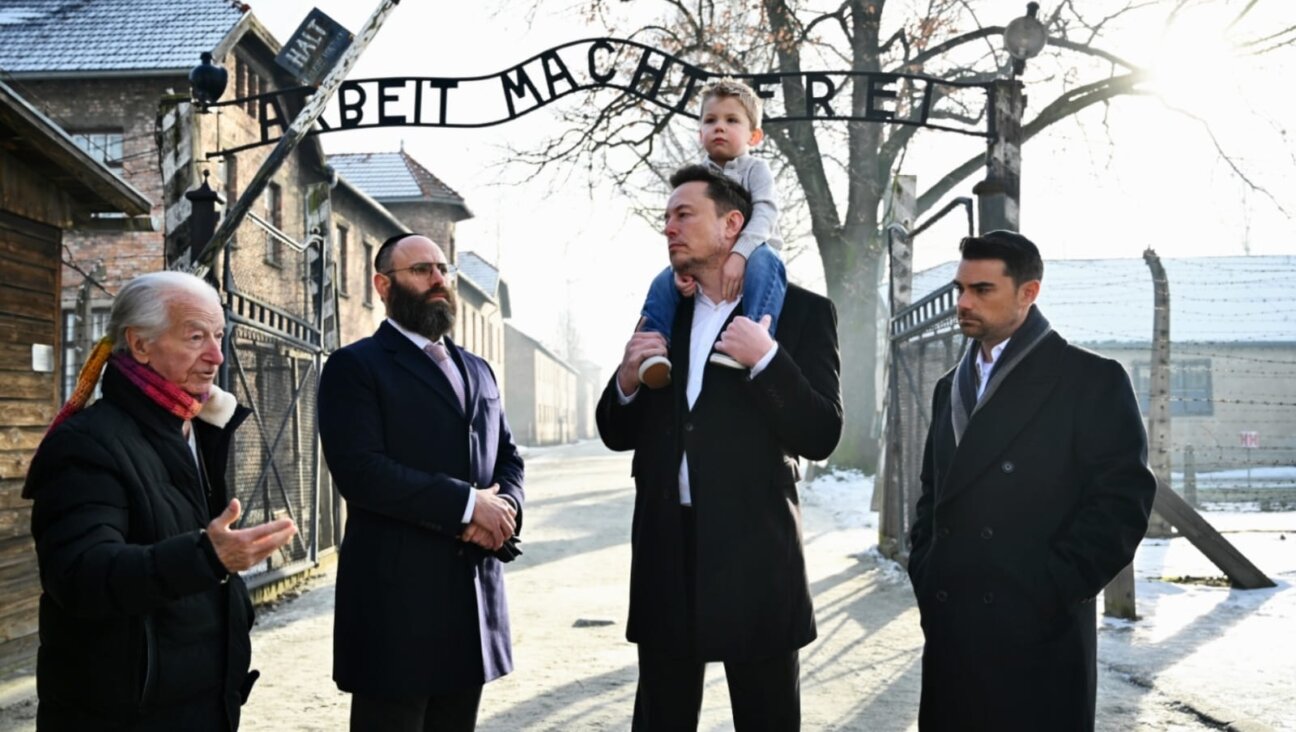Kids Lit: More Yiddish Books Begin To Sprout

Let’s say you’re raising your children in Yiddish and you want to buy them some books. What do you do? If you walk into the children’s section of any bookstore, you’ll be deluged with a huge number of engaging, beautifully illustrated books, from board books to chapter books to beautifully rendered pop-ups. But none of these books is written in Yiddish — right?

Yiddish — the ever-dying language — produced some wonderful reading material for children, including the beautifully illustrated “Yingl Tsingl Khvat” by Mani Leib (originally published in 1918 in Kiev, reissued in the United States in 1986) and Chaver-Paver’s raucously fun stories of the depression dog “Labtsik” (1935), among many, many others. Needless to say, the Yiddish children’s book market has not kept up with the times. But over the past few years, it has begun to show new life. In recent years, new editions of such classics as “The Cat in the Hat,” “Curious George” and “Winnie the Pooh” have all appeared in Yiddish. While these offerings are small potatoes compared with what’s available in English, they are nonetheless an attempt to update Yiddish children’s literature, which hasn’t seen significant action since the 1950s.
It may come as a surprise that there are some people outside of the Haredi world who are raising their children in Yiddish. The relatively small number of non-Haredi Jews who speak Yiddish comprises mostly academics and other Yiddish enthusiasts who love the language and feel that it adds a major cultural component to their lives. This Yiddish obsession is so powerful that a number of them have made the decision to raise their children in the language. These children, while not read to exclusively in Yiddish, are being guided through the literature by parents whose knowledge of it is often nonpareil.
As a result, parents such as Kenneth Moss, professor of Jewish history at Johns Hopkins University, and his wife, Anne, have made a concerted effort to expose their children to Yiddish stories. There is a division of labor: Only Ken reads in Yiddish. But he is serious about educating his children in the language, and reads to them both the classics of Yiddish children’s literature and the newer translations.
Another professorial couple at Johns Hopkins, Marc and Brukhe Caplan (he, literature; she, Yiddish language), are also raising their kids in Yiddish. The Caplan’s 4-year-old, Zippy, enjoys hearing stories in Yiddish so much, she demanded that her baby sitter (who happened to be one of Brukhe’s students) simultaneously translate the English stories she was reading her into Yiddish. Moreover, Zippy helped the baby sitter — a second-year Yiddish student — when she stumbled on a word.
Simultaneous translation while reading is a fact of life for the kinderlekh of today. While older Yiddish books often tell terrific stories, they are usually dusty editions from the 1920s and ’30s, and often pale in comparison with the new, brightly illustrated books of today. As a result, current children’s literature is often translated on the fly into Yiddish.
But this is nothing new. Dan Opatoshu, executive director of Yiddishkayt Los Angeles and the grandson of famed Yiddish writer Joseph Opatoshu, recalls that he loved hearing his grandparents read his favorite comic books and stories in Yiddish. To hear Donald Duck, Little Lulu and Freddy the Pig speak Yiddish was a unique experience and one that, no doubt, made the characters a little bit more haimish. But Opatoshu’s grandparents also read him Yiddish originals, like “Labtsik,” through whose eyes we see Brooklyn’s Brownsville section during the Depression era, and selections from Yehoash’s Yiddish translation of the Bible. All this provided him with a life-long love of Yiddish.
So what is a young reader (or read-to) of Yiddish to do? Help has arrived in the person of Zackary Sholem Berger, a doctor by trade and a Yiddishist by desire (and also a Forward contributor), who has provided Yiddish parents with high-quality translations of such classics as “Curious George,” “The Cat in the Hat” and Dr. Suess’s “One Fish, Two Fish, Red Fish, Blue Fish” (where he tastefully avoided the “gefilte fish” pun). These stories are already familiar to children and help to legitimize Yiddish as a normal language, instead of as language with an inferiority complex.
Seemingly a novelty, these translations can be considered excellent jumping-off points for the Yiddish-curious. Buy your kid “Der Kats der Payats” and, who knows, maybe it will spark dos pintele yid. And if it does, there’s more. “My First Yiddish Word Book,” a new illustrated Yiddish dictionary for children by Joni Kibort Sussman, has just been published. With this, kids can learn hundreds of Yiddish words. If their interest is further piqued, they can move on to Frida Grapa-Cielak’s “ARELE.” A new three-volume set of Yiddish instruction for children, “ARELE” would work nicely in an elementary-school setting. But really, what Jewish elementary school has the guts to take on a language representing 1,000 years of Jewish life?
None of these books, interesting and well rendered as they all are, has been able to break into what is currently the largest Yiddish children’s market: the Haredi world. Sholem Berger’s new translations won’t be found on the shelves of bookstores in Brooklyn’s Williamsburg, for the simple reason that they are not kosher for this audience. What is kosher comprises dozens of new Yiddish books that regale readers with tales of Jewish heroes, synopses of the weekly Torah portions, and quasi-instructional booklets that contain pleasant illustrations and offer young readers didactic information, such as what types of work are not permitted on the Sabbath, all in Yiddish. There are also Yiddish coloring books and workbooks — all of which accommodate the lifestyle of the Haredi community.
While it is unlikely that a Satmar child in a Kiryas Joel heder will be caught with a copy of “Kats der Payats” under his arbo-kanfes, Yiddishly engaged parents will probably use these Haredi publications to teach their children about an important part of the Yiddish world. And with the current crop of writers and translators continuing to put out fresh material, and a new generation of leading youth organizations such as Yugntruf, it may be that we will see this interesting trickle of Yiddish books turn into a stream.
The Forward is free to read, but it isn’t free to produce

I hope you appreciated this article. Before you go, I’d like to ask you to please support the Forward.
Now more than ever, American Jews need independent news they can trust, with reporting driven by truth, not ideology. We serve you, not any ideological agenda.
At a time when other newsrooms are closing or cutting back, the Forward has removed its paywall and invested additional resources to report on the ground from Israel and around the U.S. on the impact of the war, rising antisemitism and polarized discourse.
This is a great time to support independent Jewish journalism you rely on. Make a gift today!
— Rachel Fishman Feddersen, Publisher and CEO
Support our mission to tell the Jewish story fully and fairly.
Most Popular
- 1

Culture Cardinals are Catholic, not Jewish — so why do they all wear yarmulkes?
- 2

News School Israel trip turns ‘terrifying’ for LA students attacked by Israeli teens
- 3

Fast Forward Ye debuts ‘Heil Hitler’ music video that includes a sample of a Hitler speech
- 4

Fast Forward Student suspended for ‘F— the Jews’ video defends himself on antisemitic podcast
In Case You Missed It
-

Yiddish קאָנצערט לכּבֿוד דעם ייִדישן שרײַבער און רעדאַקטאָר באָריס סאַנדלערConcert honoring Yiddish writer and editor Boris Sandler
דער בעל־שׂימחה האָט יאָרן לאַנג געדינט ווי דער רעדאַקטאָר פֿונעם ייִדישן פֿאָרווערטס.
-

Fast Forward Trump’s new pick for surgeon general blames the Nazis for pesticides on our food
-

Fast Forward Jewish feud over Trump escalates with open letter in The New York Times
-

Fast Forward First American pope, Leo XIV, studied under a leader in Jewish-Catholic relations
-
Shop the Forward Store
100% of profits support our journalism
Republish This Story
Please read before republishing
We’re happy to make this story available to republish for free, unless it originated with JTA, Haaretz or another publication (as indicated on the article) and as long as you follow our guidelines.
You must comply with the following:
- Credit the Forward
- Retain our pixel
- Preserve our canonical link in Google search
- Add a noindex tag in Google search
See our full guidelines for more information, and this guide for detail about canonical URLs.
To republish, copy the HTML by clicking on the yellow button to the right; it includes our tracking pixel, all paragraph styles and hyperlinks, the author byline and credit to the Forward. It does not include images; to avoid copyright violations, you must add them manually, following our guidelines. Please email us at [email protected], subject line “republish,” with any questions or to let us know what stories you’re picking up.















